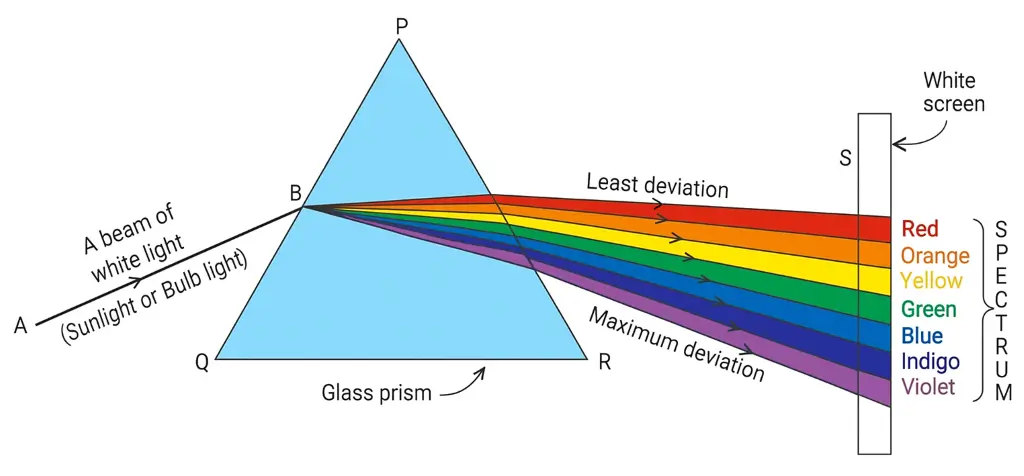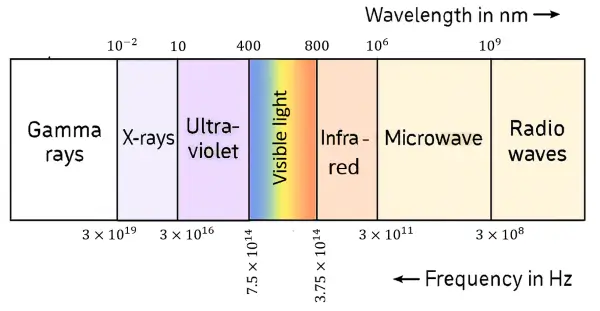ICSE Class 10 Spectrum Notes – Physics Revision Guide
The ICSE Class 10 Physics Spectrum chapter is an important part of the syllabus and is frequently asked in exams. Students preparing for board exams should have clear and concise Spectrum notes to revise all the concepts, definitions, and numericals quickly.
In this blog, we provide ICSE Class 10 Spectrum Notes, Selina Solutions, and important questions to help you strengthen your preparation.
Study Support by Rohit Academy
Rohit Academy offers expert-curated ICSE Class 10 Physics Study Materials including ICSE Spectrum Chapter Notes, diagrams, and key formulas for better understanding.
Study materials related to chapter 6 Spectrum
| Class 10 Concise Physics Chapter 6 Spectrum Ex 6(A) Solutions |
| Class 10 Concise Physics Chapter 6 Spectrum Ex 6(B) Solutions |
| Class 10 Concise Physics Chapter 6 Spectrum Ex 6(C) Solutions |
| Class 10 Chapter 6 – Spectrum Previous Year Questions |
Section A : Deviation, Dispersion and Spectrum
Deviation Produced by a Triangular Prism
- A triangular glass prism has two triangular bases and three rectangular lateral surfaces. These surfaces are inclined to each other. The angle between its two lateral faces is called the angle of the prism.
- When a ray of light passes from one medium to another medium, it gets deviated from its path because of the difference in speeds of light in the two media.

- PQRS is pathway of light through prism.
Different Rays:
- Ray PQ → Incident ray on surface AB
- Ray QR → Refracted ray between surface AB and BC
- Ray RS → Emergent ray at surface AC
- N1N & N2N → Normal at point of incidence and emergence
Different Angles:
- ∠𝐴 → 𝐴𝑛𝑔𝑙𝑒 𝑜𝑓 𝑝𝑟𝑖𝑠𝑚
- ∠𝑖1 → 𝐴𝑛𝑔𝑙𝑒 𝑜𝑓 𝑖𝑛𝑐𝑖𝑑𝑒𝑛𝑐𝑒 𝑎𝑡 𝑠𝑢𝑟𝑓𝑎𝑐𝑒 𝐴𝐵
- ∠i2 = ∠e → Angle of incidence (angle of emergence) at surface AC
- ∠ 𝑟1 → 𝐴𝑛𝑔𝑙𝑒 𝑜𝑓 𝑟𝑒𝑓𝑟𝑎𝑐𝑡𝑖𝑜𝑛 𝑎𝑡 𝑠𝑢𝑟𝑓𝑎𝑐𝑒 𝐴𝐵
- ∠ 𝑟2 → 𝐴𝑛𝑔𝑙𝑒 𝑜𝑓 𝑟𝑒𝑓𝑟𝑎𝑐𝑡𝑖𝑜𝑛 𝑎𝑡 𝑠𝑢𝑟𝑓𝑎𝑐𝑒 𝐴𝐶
- ∠ 𝛿 → 𝐴𝑛𝑔𝑙𝑒 𝑜𝑓 𝑑𝑒𝑣𝑖𝑎𝑡𝑖𝑜𝑛
- 𝛿 = 𝛿1 + 𝛿2
- Angle of incidence (i1) = Angle of emergence (i2)
- Angle of Deviation: The angle between incident ray and emergent ray is called angle of deviation.
- 𝑨 = 𝒓𝟏 + 𝒓𝟐
- 𝛿1 = 𝑖1 − 𝑟1
- 𝛿2 = 𝑖2 − 𝑟2
- 𝛿 = 𝛿1 + 𝛿2
- 𝛿 = (𝑖1 − 𝑟1) + (𝑖2 − 𝑟2)
- 𝛿 = (𝑖1 + 𝑖2) − (𝑟1 + 𝑟2)
- 𝛿 = (𝑖1 + 𝑖2) − 𝐴
- 𝜹 = (𝒊 + 𝒆) − 𝑨
Factors affecting deviation by a prism :
(i) Angle of incidence (i) : deviation first decreases, becomes minimum at the angle of minimum deviation, then increases as i increases.
(ii) Angle of prism (A) : larger A gives larger deviation.
(iii) Refractive index / colour (μ or λ) : higher μ (shorter wavelength) gives larger deviation.
Dependence of deviation on the colour (or wavelength) of light
- The speed of light of all the colours is the same in air (or vacuum), but in any other transparent medium, the speed of light is different for different colours.
- The speed of light in a transparent medium decreases with the decrease in the wavelength of light.
- In a given medium, the speed of red light is maximum and that of the violet light is least.
- Thus, in the visible spectrum, red colour (λ = 8000 Å) is deviated the least and violet (λ = 4000 Å) is deviated the most.
- The refractive index of a transparent medium is maximum for violet light and least for red light.
- Colour of light is the subjective property of light related to its wavelength.
***Note
- Red colour ⇨ Highest Wavelength ⇨ Maximum Velocity ⇨ Least Deviation ⇨ least frequency
- Violet colour ⇨ least Wavelength ⇨ Minimum Velocity ⇨ maximum Deviation ⇨ maximum frequency
DISPERSION OF WHITE LIGHT BY A GLASS PRISM

- Dispersion : Splitting of white light by a prism into its constituent colours is called dispersion.
- Spectrum : The band of colours obtained when white light passes through a prism is called the spectrum.
- Order of colours (from base side): Violet, Indigo, Blue, Green, Yellow, Orange, Red (VIBGYOR).
Cause of Dispersion
- Light of different colours has different wavelengths and speeds in glass.
- Different colours deviate by different angles at the first surface of the prism.
- Violet deviates the most; Red deviates the least.
- At the second surface, only refraction occurs → colours spread further to form the spectrum.
Important Notes
- Dispersion occurs only at the first surface of the prism.
- Deviation of rays occurs at both surfaces of the prism.
- A prism does not create colours; it only separates those already present in white light.
- In the spectrum, colours merge gradually → no sharp boundaries.
- \(Wavelength\ \propto\ Velocity\ \propto\ \frac{1}{\ Deviation}\)
Section B : Electromagnetic Spectrum and its Broad Classification
Electromagnetic Spectrum
- The portion of the spectrum between red and violet colours is the visible spectrum, and it is only a small part of the entire electromagnetic spectrum.
- The portion of the spectrum just beyond the red end is called the infrared spectrum, while the portion of the spectrum just before the violet end is called the ultraviolet spectrum.
- The waves of wavelength longer than the red part of the visible spectrum in increasing order of wavelength are (i) infrared radiations (ii) microwaves (iii) radio waves
- The waves of wavelength shorter than the violet part of the visible spectrum in decreasing order are (i) ultraviolet rays (ii) X-rays (iii) gamma rays.
- The speed(c), frequency(f) and wavelength (λ) of electromagnetic waves are related as \(c=f\lambda\)
- When an electromagnetic wave passes from one medium to another, the frequency of the wave remains unchanged. This is a fundamental property of electromagnetic waves.
- 1 nm = 10-9 m = 10 Å
Properties of Electromagnetic Waves
- Do not need material medium for propagation.
- Travel at speed of light \(\left(3\times{10}^8\ m/s\right)\) in vacuum.
- Show reflection and refraction (frequency unchanged on refraction).
- Not deflected by electric/magnetic fields.
- Transverse in nature.
Quick Memory Trick:
“Good Xylophones Use Very Interesting Musical Rhythms”
(Gamma, X-rays, Ultraviolet, Visible, Infrared, Microwaves, Radio)
Ranges of electromagnetic waves
| Name of the wave | Wavelength | Frequency |
| Gamma rays | \(Less\ than\ 0.1\ Å\) \(\left(or,\ 0.01\ nm\right)\) | \(Greater\ than\ 3\times{10}^{19}\ \ Hz\) |
| X-rays | \(0.1\ Å\ to\ 100\ Å\)\(\left(or,\ \ 0.01\ nm\ to\ 10\ nm\right)\) | \(3\times{10}^{19}\ to\ \ 3\times{10}^{16}\ Hz\) |
| Ultraviolet | \(100\ Å\ to\ 4000 Å\)\(\left(or,\ \ 10\ nm\ to\ 400\ nm\right)\) | \(3\times{10}^{16}\ to\ \ 7.5\times{10}^{14}\ Hz\) |
| Visible Light | \(4000\ Å\ to\ 8000 Å\)\(\ \left(or,\ \ 400\ nm\ to\ 800\ nm\right)\) | \(7.5\ \times{10}^{14}\ to\ \ 3.75\times{10}^{14}\ Hz\) |
| Infrared waves | \(8000\ Å\ to\ 10^7 Å\)\(\left(or,\ \ 800\ nm\ to\ {10}^6\ nm\right)\) | \(3.75\ \times{10}^{14}\ \ to\ \ 3\times{10}^{11}\ Hz\) |
| Microwaves | \(10^7\ Å\ to\ 10^{11} Å\)\(\left(or,\ \ {10}^6\ nm\ to\ {10}^{10}\ nm\right)\) | \(3\ \times{10}^{11}\ \ to\ \ 3\times{10}^7\ Hz\) |
| Radio waves | \(more\ than\ 10^{11} Å\)\(\left(or,\ \ {10}^{10}\ nm\right)\) | \(below\ 3\ \times{10}^7\) |

***Note
- Most energetic : Gamma rays;
- Least energetic : Radio waves
- Wavelengths : Gamma < X-rays < Ultraviolet < Visible < Infrared < Microwaves < Radio
1. Gamma rays
- Wavelength of gamma rays: \(Less\ than\ 0.1\ Å\ \left(or,\ 0.01\ nm\right)\)
- Frequency of gamma rays: \(Greater\ than\ 3\times{10}^{19}\ \ Hz\)
- Source of gamma rays: In cosmic rays, In radiations from radioactive substances
- Method of detection of gamma rays: By their large penetrating power
❖ Properties of gamma rays:
(i) These are the most energetic electromagnetic radiations of wavelengths less than 0.1 Å (0.01 nm).
(ii) They cause fluorescence when they strike fluorescent materials (e.g., zinc sulphide).
(iii) Very high penetrating power, can pass through thick metallic sheets.
(iv) Gamna-rays can easily penetrate through the human body.
❖ Uses of gamma rays:
(i) In medical science, to kill cancer cells.
(ii) In industry, to check welding.
(iii) They are used to produce nuclear reactions.
(iv) It provides valuable information about the structure of the atomic nucleus.
2. X-rays
- Wavelength of X-rays: \(0.1\ Å\ to\ 100\ Å\ \left(or,\ \ 0.01\ nm\ to\ 10\ nm\right)\)
- Frequency of X-rays: \(3\times{10}^{19}\ to\ \ 3\times{10}^{16}\ Hz\)
- Source of X-rays: When highly energetic electrons are stopped by a heavy metal target of high melting point.
- Method of detection of X-rays: By the fluorescence produced on a zinc sulphide screen. The photographic film gets affected.
❖ Properties of X-rays:
(i) They have high penetrating power.
(ii) They strongly affect the photographic plate.
(iii) They cause fluorescence in certain material such as zinc sulphide, etc.
❖ Uses of X-rays:
(i) Medical (fracture detection, CAT scans).
(ii) They are also used for studying atomic arrangement in crystals as well as in complex molecules.
(iii) They are used by detective agencies to detect hidden objects/precious metals.
3. Ultraviolet radiations
- Wavelength of UV: \(100\ Å\ to\ 4000 Å\ \left(or,\ \ 10\ nm\ to\ 400\ nm\right)\)
- Frequency of UV: \(3\times{10}^{16}\ to\ \ 7.5\times{10}^{14}\ Hz\)
- Source of UV: Electric arc and sparks, Mercury vapor lamp, Sun (though much of it is absorbed by the ozone layer)
- Method of detection of UV:
Detected by their effect on silver chloride, dyes, and photographic plates.
Spectrum obtained using a quartz prism (not glass, since glass absorbs UV).
❖ Properties of UV:
(i) Pass through quartz but not glass.
(ii) Travel in straight lines with speed of light (3 × 108 m/s).
(iii) Scattered by dust particles in the atmosphere.
(iv) Obey laws of reflection/refraction.
(v) Strongly affect photographic plates (chemically more active than visible light).
(vi) Produce fluorescence (e.g., on zinc sulphide screen).
❖ Uses of UV:
(i) For sterilising purposes.
(ii) For detecting the purity of gems, eggs, ghee etc.
(iii) Producing Vitamin D in food and animals
4. Visible Light
- Wavelength of Visible Light: \(4000\ Å\ to\ 8000 Å\ \ \left(or,\ \ 400\ nm\ to\ 800\ nm\right)\)
- Frequency of Visible Light: \(7.5\ \times{10}^{14}\ to\ \ 3.75\times{10}^{14}\ Hz\)
- Source of Visible Light: Sunlight, bulbs, flame, hot bodies
- Method of detection of Visible Light: Seen by human eye
❖ Properties of Visible Light:
(i) The electromagnetic radiations of wavelengths from 4000 Å to 8000 Å are called visible radiations.
(ii) The Sun, an electric bulb, a flame and hot bodies are the main sources of visible light.
(iii) The prominent colours of visible light are violet, indigo, blue, green, yellow, orange and red.
❖ Uses of Visible Light:
- Photography, photosynthesis, seeing objects around us.
5. Infrared waves
- Wavelength of Infrared waves: \(8000\ Å\ to\ 10^7 Å\ \left(or,\ \ 800\ nm\ to\ {10}^6\ nm\right)\)
- Frequency of Infrared waves: \(3.75\ \times{10}^{14}\ \ to\ \ 3\times{10}^{11}\ Hz\)
- Source of Infrared waves: All red-hot bodies (iron ball, flame, fire, etc.); Sun is the natural source.
❖ Method of detection of Infrared waves:
- Thermometer (blackened bulb) shows heating effect near red end of spectrum.
- Thermopile shows deflection when IR falls on it.
- Rock-salt prism used to obtain IR spectrum (glass absorbs IR).
❖ Properties of Infrared waves:
(i) Travel in straight lines at speed of light.
(ii) Obey laws of reflection and refraction.
(iii) Produce heating effect (can burn paper with convex lens).
(iv) Do not affect ordinary photographic film (special films can detect).
(v) Absorbed by glass, pass through rock-salt.
(vi) Detected by heating property (thermometer, thermopile).
(vii) Scattered less by atmosphere → penetrate fog/mist.
(viii) Greenhouse gases absorb low-energy IR, keeping Earth warm.
❖ Uses of Infrared waves:
(i) Therapeutic purposes in medicine.
(ii) They are used in photography at night and also in mist and fog because they are not scattered much, so they can penetrate appreciably through these.
(iii) Infrared lamps in dark rooms for photo development.
(iv) They are used as signals during war as they are not visible and they are not absorbed much in the medium.
(v) Remote controls of TV and gadgets.
6. Microwaves
- Wavelength of Microwaves: \(10^7\ Å\ to\ 10^{11} Å\ \left(or,\ \ {10}^6\ nm\ to\ {10}^{10}\ nm\right)\)
- Frequency of Microwaves: \(3\ \times{10}^{11}\ \ to\ \ 3\times{10}^7\ Hz\)
- Source of Microwaves: Electronic devices, crystal oscillators
- Method of detection of Microwaves: Oscillatory electrical circuit.
❖ Properties of Microwaves:
(i) These waves are produced by electronic devices such as a klystron tube.
(ii) They have wavelengths ranging from 107 Å to 1011 Å (or 1 mm to 10 m) or frequency in the range of 3 x 1011 Hz to 3 x 107 Hz.
❖ Uses of Microwaves:
(i) Satellite communication.
(ii) Atomic and molecular structure analysis.
(iii) Microwave ovens (cooking).
(iv) Radar communication.
7. Radio waves
- Wavelength of Radio waves: \(more\ than\ 10^{11} Å\ \left(or,\ \ {10}^{10}\ nm\right)\)
- Frequency of Radio waves: \(below\ 3\ \times{10}^7\)
- Source of Radio waves: TV and radio transmitters
- Method of detection of Radio waves: Radio/TV aerial receivers
❖ Properties of Radio waves:
- These waves have the longest wavelength among all the electromagnetic waves.
- They have wavelength above 1011 Å (or 10 m) or frequency below 3 x 107 Hz.
- They show all the properties of electromagnetic waves.
❖ Uses of Radio waves:
- They are mainly used in radar communication and in radio and television transmission.
Section C : Scattering of light and its applications
SCATTERING OF LIGHT
- The phenomenon of irregular reflection of light by the small particles suspended in a medium in all directions is called scattering of light.
- Making the path of light visible.
- Shorter the wavelength, greater will be scattering.
- The intensity of scattered light is found to be inversely proportional to the fourth power of the wavelength of light. \(\left(i.e.,\ \ I\propto\ \frac{1}{\lambda^4}\right)\)
- When sunlight enters the earth’s atmosphere,
(i) Violet is scattered the most.
(ii) Red is scattered the least.
Dependence of colour of scattered light
- If particles are very fine, they scatter mainly the blue colour of light (shorter wavelength).
- Medium sized particles scatter mainly the red colour (longer wavelength).
- Even larger particles scatter all the colours of light that is why it appears white.
Danger signs are made in red colour
In the visible light, the wavelength of red light is longest, therefore the light of red colour is scattered least by the air molecules of the atmosphere.
Hence red light is used for danger signal, so that the signal may be visible from the far distance even in fog, etc.
Colour of sky is blue

The upper layer of atmosphere contains very fine particles of water vapours and gases. These particles are more effective in scattering of light of shorter wavelength mainly blue than larger wavelength. So, the sky appears blue.
Clouds appear white
Clouds are formed by water vapours. Water vapours condense to form water droplets due to larger size of droplets, all colours of light are scattered and clouds appear white.
Appearance of sky to passengers flying at very high altitudes.
If earth had no atmosphere than there would not have been any scattering, then the sky would have looked dark. The sky appears dark to passengers flying at very high altitudes.
Colour of the Sun at Sunrise and Sunset
While sunset and sunrise, the colour of the sun and its surrounding appear red. During sunset and sunrise, the sun is near horizon and therefore the sunlight has to travel larger distance in atmosphere.
Due to this most of the blue light (shorter wavelength) are scattered away by the particles. The light of longer wavelength (red colour) will reach our eye.
This is why sun appear red in colour.
ICSE Class 10 Spectrum Physics Notes PDF Download
To help you revise quickly, we are providing ICSE Class 10 Spectrum Physics Notes PDF Download with key concepts, Selina Solutions, and important questions.
Final Tip for ICSE Students
Revise the ICSE Class 10 Spectrum Physics Notes PDF daily, practice diagrams, and solve numericals regularly. With consistent preparation, you can easily score full marks in this chapter.
You can also visit :
| ICSE Class 10 Physics |
| ICSE Class 10 Chemistry |
| ICSE Class 10 Mathematics |
ICSE Class 10 Physics Notes
| ICSE Class 10 Physics Chapter 1 – Force Notes |
| ICSE Class 10 Physics Chapter 2 – Work, Energy and Power Notes |
| ICSE Class 10 Physics Chapter 3 – Machines Notes |
| ICSE Class 10 Physics Chapter 4 – Refraction of Light at Plane Surfaces Notes |
| ICSE Class 10 Physics Chapter 5 – Refraction through Lens Notes Notes |
| ICSE Class 10 Physics Chapter 6 – Spectrum Notes |
| ICSE Class 10 Physics Chapter 7 – Sound Notes |
| ICSE Class 10 Physics Chapter 8 – Current Electricity Notes |
| ICSE Class 10 Physics Chapter 9 – Electrical Power and Household Circuits Notes |
| ICSE Class 10 Physics Chapter 10 – Electro-magnetism Notes |
| ICSE Class 10 Physics Chapter 11 – Calorimetry Notes |
| ICSE Class 10 Physics Chapter 12 – Radioactivity Notes |

